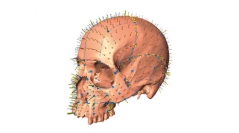

 Comptes Rendus Palevol
9 (6-7) - Pages 435-443
Comptes Rendus Palevol
9 (6-7) - Pages 435-443The increasing availability of 3D data and tools offers new analytical perspectives in palaeoanthropology, such as the quantitative testing of opposing phylogenetic scenarios. Using optical surface scan data and geometric morphometric techniques, this study explores calvarial shape variation in the “Middle Pleistocene muddle”. The morphological variability between H. erectus on the one hand and H. sapiens/neanderthalensis on the other has long remained obscure: opposing views have attributed the known specimens to any of the three species and possibly one or two more. A large number of landmarks and semilandmarks was extracted from the braincase and the face, in order to quantify the calvarial shape differences among species and key fossils. The results are incompatible with the hypothesis that H. rhodesiensis is the exclusive ancestor of H. sapiens, and offer only weak support for an exclusively European ancestor of Neandertals.
3D surface scanning, Geometric morphometrics, Neandertals, Homo heidelbergensis, Homo rhodesiensis, Middle Pleistocene